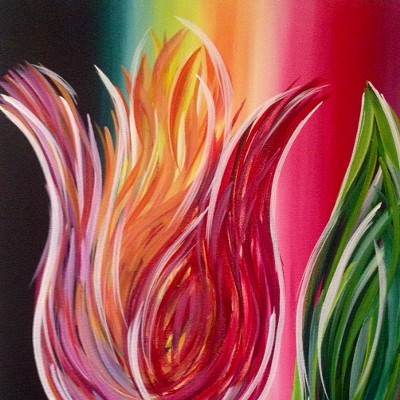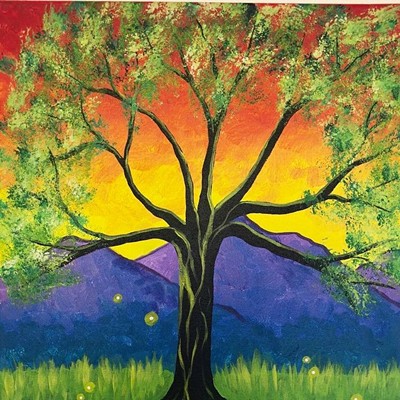After a long period of trendy "installations, videos, photographs, films and digital animations," the Biennial artists have once again turned to "painting and drawing--the visual mediums in which the creative cooperation of hand, eye and imagination attains peak efficiency," as Schjeldahl so eloquently put it.
He could have been be describing the luscious work displayed in Joe Forkan: Paintings, the show now up at Tucson's Temple Gallery. Forkan has filled the space with 27 works large and small, all of them celebrations of the old-fashioned--and now new-fashioned--art of painting. Paintings on canvas, paintings on wood and pastels on paper luxuriate in color on color, in textures thick and thin, in shapes and lines, and in the imaginative worlds these physical things can miraculously conjure up.
Even Forkan's subjects hearken back to painting's old days, embracing everything from the traditional studio nude to portraits to architecture, and from figures in a landscape to pure landscape. About the only thing left out of the classical canon here is the still-life. But old as these subjects are, Forkan's too gifted a painter to turn out tired academic art. He demonstrates his mastery of the assorted genres--they're almost too easy for him--and then goes on to transform them.
The large "Studio, 2004," an oil on canvas, is beautifully painted, but at first glimpse, it seems like nothing more than a conventional studio nude. The full-frontal model, her body lit by harsh studio lights, stands amid the clutter in the painter's studio, a classic setting that allows a little background geometry behind her undulating curves. A dark canvas leans diagonally against the wall to her right; brown rectangles (of furniture?) are piled up on her left; a turquoise cloth pools in a circle beneath her feet. There are even pots of paint stacked up, in pale lime, blue and yellow, an homage to the art of painting itself and to the infinity of painters, from Velasquez on down, who celebrated their studios in paint.
But traditional as all these elements are, this nude goes beyond a standard-issue study. Her hands are restless, as if she's ready to make a point, or to pounce. And her face, turned to the right, is blurred--its features disappearing into abstracted layers of paint.
This sudden disruption of the literal image presages the techniques in the show's most ambitious work, "Interior, 2002," a huge triptych in oil on canvas on panel. The three-part painting appears to picture a female figure first in a landscape, then in an interior, then in the sky, but she grows successively more obscure in each of the three panels. The lines of her body literally vanish into the paint.
At left, she's most distinct, a figure with one hand held across her breast (a lovely gesture that Forkan often returns to). Yet she's almost more of an excuse for bravura brushwork than she is a literal woman. She's painted in shiny gold, like a Madonna apparition, and she's set amid layered greens that go from leaf to lime to earth, and lavenders, roses and blues. A dash of yellow paint slashes across the canvas. A patch of white on the horizon line is a mere suggestion of a house, a stroke of green its roof.
In the middle panel, she becomes flesh, in color at least, her vaguely crouching body glowing in peach, orange and gold. She seems to be in a dark interior space with the green light of nature coming through a window-opening. By the final picture, she's like an abstracted El Greco Assumption rising up into heaven, her figure having metamorphosed into an explosion of orange, flesh and magenta light. "Interior" makes an imaginative leap from figuration to abstraction, and back again.
Forkan often interrupts the surface of his paint, by combing it or attacking it with a palette knife or thinning it with medium. But though they show off his considerable skill with the tools of his trade, these methods are not just idle exercises. They help diminish the literalism of his drawings, and give them an emotional, even haunted quality.
"Drift 1, 2002," a small oil on wood panel, blurrily pictures a couple from the past, their stylish overcoats--his blue, hers reddish-brown--placing them in the 1940s or '50s. Posing in the left-hand side of an open field, under a broad sky spilling down to the horizon, they have the look of people fading away in a photograph, or remembered fuzzily in a descendant's memory. Forkan mimics the tricks memory plays by literally running a comb through the paint, stretching the figures out, blurring and almost erasing them.
"Drift 2, 2002" repeats this ghostly couple three times, and each rendition boasts a different painting technique. At left, the man and woman are near-blurs in thin, slick, glossy paint, colored in wintry browns and blues. At center, they're thicker, more distinguishable, in summery blues and greens. Finally, they blaze autumnally in rust, gold and orange. Though nature shifts and storms around them, they remain steadfast, immovable in memory.
A series of deft architectural studies experiments with the light and color on a single California cityscape at varying times of day. Like Manet with his Houses of Parliament, Forkan documents the lavender shadows of early morning, the flat brilliance of noon, the inky blue of midnight. These deft renderings of the Spurgeon Building faithfully record the sloping roofs and boxy façades of a 1930s street, and even include a green-shaded window that at one and the same time conjures up Nathaniel West and Edward Hopper.
Forkan has a little bit of both West and East in him. Now an assistant art professor at California State University at Fullerton, Forkan got an MFA at the University of Delaware. Before that, he lived in Tucson, where his brooding cartoons and full-color paintings once graced the Tucson Weekly's covers. He's exhibited in Tucson in years past, but with more training and more years in the studio, Forkan is painting better than ever. Unlike some of the Biennial artists, he's never strayed far from his old-fashioned art, doing most of his experimenting within the confines of oils, pigments and the picture plane. An immensely gifted painter, he seems incapable of a bad color judgment or of a faulty turn of the brush. It's good to have Forkan--and painting--back.














